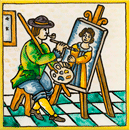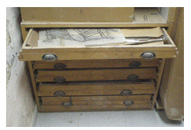ca:
SOBRE ESMALT - tercera cocció
es:
SOBRE ESMALTE - tercera cocción
Click on the title to see more images
 ON-GLAZE: Also known as OVER-GLAZE or ENAMEL COLORS.
ON-GLAZE: Also known as OVER-GLAZE or ENAMEL COLORS.
On-glaze is when an already fired glaze is decorated with ceramic colors and fired again. The work must be fired three times, bisque, glaze-base and decoration. There is a large range of commercially prepared colors that can be fired between 700º C and 850º C and they can be bought in the form of powder, liquid or small blocks. Work can be decorated, fired, then have more colors added and re-fired at the same or lower temperature; this does not affect the colors of the first firing. In many countries this method is known as “Porcelain Decorating,” not because it is put onto porcelain ware but because it is painted using a similar method.
The problem with painting onto a fired glaze is that colors cannot adhere to it, so they spread, run and separate while you work. You can counteract this by putting a thin layer of gum-Arabic on the place you are going to decorate or repair; this holds the colors and when fired, it burns away, leaving the colors fused to the surface. It can also be done by mixing the colors with an oil medium or varnish and turpentine.
If you prepare your own colors you must be sure that the powder is dry, as the products they are going to be mixed with will not tolerate water. If damp, spread the powder out on a piece of newspaper and put it in a warm place to dry out.
Working sequence:
1) Either an oil medium or varnish can be mixed with the colors. The varnish is the ordinary, colorless one used to paint wood.
2) Prepare the varnish in the following proportions: 1 part varnish to 3 parts good quality turpentine, which you should buy it at a chemist. When prepared, keep it in a bottle that shuts well. Do not make more than you need as it hardens.
3) Prepare the colors needed in the correct proportions and mix them with oil or varnish.
4) On a non-absorbent slab, using a palette knife, mix them together until they are completely integrated and have a thick smooth texture.
5) Mark the prepared design onto the tiles with charcoal powder or carbon paper. If charcoal powder, do it when the work has been covered with a thin layer of gum-Arabic, so it adheres to the tiles.
6) Paint on your design using the prepared colors; some colors might need two coats.
7) Leave to dry for about 12 hours.
8) When the decoration is finished and completely dry it can be left as it is, or covered with a thin layer of transparent glaze. In the former case, the difference between the first and second firing can be noticed; the decoration and the base are not at the same level and this can be seen and touched. To avoid this, cover the whole work with a thin layer of transparent glaze using a large, soft brush and taking care not to damage the decoration. This will leave a thin white coat; it may be thicker in some parts where it overlaps, but this is of no importance, as when fired it will have a smoothly integrated finish and touch, like an in-glaze.
Fire it at the heat the colors you are using are prepared for.
FISHERMAN AND THE STORM
Both pictures below were prepared with a crackle glaze-base and fired. They were then painted using the on-glaze method but with colors prepared for working with the Majolica Method. Everything is done in the same way as explained above, except it must be fired at 980º C; we do this so it can be fired with other work we create using the Majolica Method and there is no need to wait to fill up the kiln to fire at a lower heat. After the colors were fired, the tiles were rubbed with a prepared dark color so it integrated into the cracks, then with damp cloth all the surplus paint was cleaned off; this leaves the cracks dark, so they can be seen.
Read more about: In-glaze / Underglaze / Transfer
 Occupations are one tile designs that illustrate, with figures, the different ways of working. They are painted with the Majolica method, which was brought to Spain by the Arabs. When the Arab influence declined it became an illustrated method of informing the illiterate pubic.
Occupations are one tile designs that illustrate, with figures, the different ways of working. They are painted with the Majolica method, which was brought to Spain by the Arabs. When the Arab influence declined it became an illustrated method of informing the illiterate pubic.  Ochre is an earth color, the base of which is yellow. Red and brown are added in different intensities to give different shades.
Ochre is an earth color, the base of which is yellow. Red and brown are added in different intensities to give different shades.  ON-
ON-
 Open is when a door, lid, drawer, etc., is not in a shut or closed position so the interior is accessible. In the photo, the lid of the kiln is open.
Open is when a door, lid, drawer, etc., is not in a shut or closed position so the interior is accessible. In the photo, the lid of the kiln is open.
 Oval-ware refers to oval shaped pieces of pottery, plates, decorative and kitchenware used for cooking in the oven or on top of the heat, like casseroles, etc. and designed to bring food directly from the oven to the table.
Oval-ware refers to oval shaped pieces of pottery, plates, decorative and kitchenware used for cooking in the oven or on top of the heat, like casseroles, etc. and designed to bring food directly from the oven to the table.